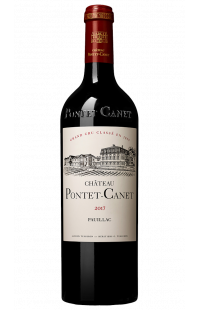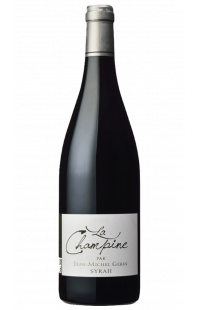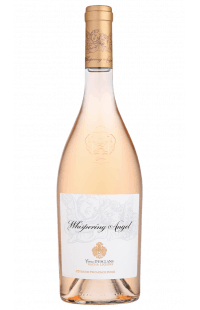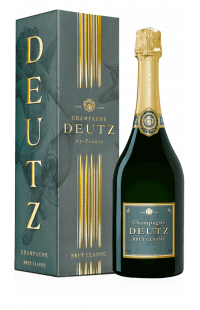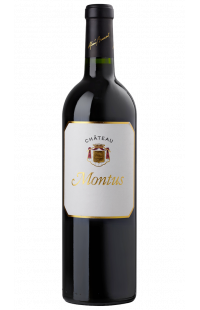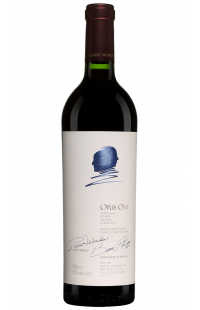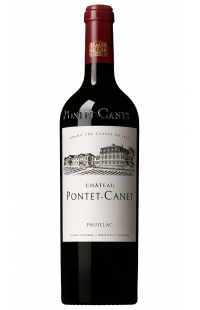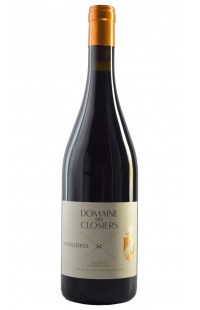- Menu
- All our wines
- Bordeaux
-
Rhône
-
Burgundy
-
Rosés Wines
-
Champagne
- France
-
World
- PRIMEURS
- ORGANIC WINES
Saumur Champigny Wines
There are 4 products.
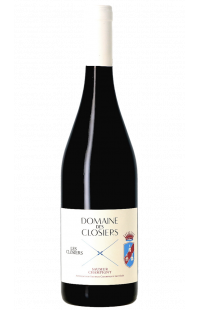
Available in
- Bottle (75cl)
- 23.90€ / bottleTASTING NOTES
Specifications
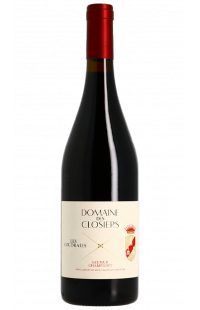
Available in
- Bottle (75cl)
- 40.00€ / bottleTASTING NOTES
Specifications
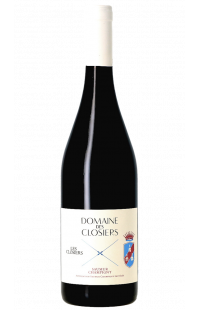
Available in
- Magnum (1,5l)
- 50.00€ / magnumTASTING NOTES
Specifications
Discover Exceptional Wine: Saumur Champigny
Discover everything about Saumur Champigny, an exceptional red wine made from the Cabernet Franc grape, produced in Maine-et-Loire. Learn about its history, terroir, and unique characteristics.
Saumur Champigny is a renowned red wine from the Loire Valley, celebrated for its exceptional quality and distinctive aromas. Exclusively made from the Cabernet Franc grape, this wine stands out for its unique terroir and favorable climate. In this article, we will explore the various facets of Saumur Champigny, from its terroir to its organoleptic characteristics, including its winemaking process.
History of Saumur Champigny
Origins
Saumur Champigny traces its origins to the Saumur region, located in the Maine-et-Loire department. Since Roman times, this area has been recognized for the quality of its wines. The earliest mentions of vineyards in this region date back several centuries, highlighting a long-standing viticultural tradition.
Evolution Through the Ages
Over the centuries, viticulture and winemaking techniques have evolved, thereby enhancing the quality of the produced wine. The introduction of the Cabernet Franc grape marked a decisive turning point, giving Saumur Champigny its unique characteristics.
Recognition as AOC
In 1957, Saumur Champigny obtained the Appellation d'Origine Contrôlée (AOC), an official recognition of the quality and authenticity of this wine. This distinction ensures that only bottles meeting strict production criteria can bear the name Saumur Champigny.
Terroir and Climate
The Nine Communes
The AOC Saumur Champigny extends over nine communes: Chacé, Champigny, Montsoreau, Parnay, Saint-Cyr-en-Bourg, Saumur, Souzay-Champigny, Turquant, and Varrains. Each of these communes contributes to the diversity and richness of the terroir.
Oceanic Climate
The region's climate is oceanic, characterized by mild winters and temperate summers. This favorable climate allows optimal grape maturation, essential for producing high-quality wines.
Soil Composition
The soil on which Saumur Champigny vines grow is primarily composed of sand, gravel, and clay. This unique soil composition plays a crucial role in the development of the wine's aromas and structure.
The Grape Variety: Cabernet Franc
Grape Characteristics
Cabernet Franc, the main grape variety of Saumur Champigny, is known for its resilience and ability to adapt to various climatic conditions. It produces wines with a beautiful structure, fruity and spicy aromas, and balanced acidity.
Adaptation to Terroir
In the terroir of Saumur Champigny, Cabernet Franc fully expresses its potential. Rich soils and a temperate climate allow this grape variety to produce high-quality grapes, resulting in wines of great finesse.
Winemaking Process
Harvesting
Harvesting in Saumur Champigny is typically done by hand, allowing for a rigorous selection of clusters. This traditional method ensures the quality of the grapes used for winemaking.
Fermentation
The fermentation of Saumur Champigny takes place in tanks, where natural yeasts convert the grape sugars into alcohol. This stage is crucial for the development of the wine's aromas and structure.
Aging
After fermentation, the wine is aged in tanks or barrels for several months. This aging process allows the wine to refine and develop its aromatic complexity.
Characteristics of Saumur Champigny
Color
Saumur Champigny is distinguished by its garnet red hue, bright and luminous. This color is an indicator of the wine's youth and liveliness.
Aromas
On the nose, Saumur Champigny reveals a rich and complex aromatic palette. Notes of red fruits, such as cherry and raspberry, are blended with spicy and licorice aromas.
Texture and Taste
On the palate, Saumur Champigny is full-bodied and balanced. Its tannic structure is supple, offering a velvety sensation. The freshness at the finish contributes to a sense of lightness and elegance.
Consumption and Storage
Young vs. Aged
Saumur Champigny can be consumed young, when its fruity aromas are at their peak. However, it gains complexity after a few years of aging, revealing more evolved and profound notes.
Storage Tips
To store Saumur Champigny under the best conditions, it is recommended to keep it in a cool and dark place with a stable temperature. A wine cellar is ideal to ensure optimal maturation.
Food and Wine Pairings
Traditional Dishes
Saumur Champigny pairs perfectly with traditional French dishes, such as coq au vin, pork rillettes, or rabbit with mustard.
Modern Suggestions
For more modern pairings, try Saumur Champigny with vegetarian dishes like mushroom quiche or mildly spiced vegetable curry.
Major Producers
Renowned Estates
Several renowned estates produce Saumur Champigny, each bringing their own touch to the wine. Notable among them are Domaine des Roches Neuves, Domaine Filliatreau, and Château de Villeneuve.
Innovative Winemakers
Emerging innovative winemakers are also making their mark, experimenting with natural and biodynamic winemaking techniques, contributing to the evolution and diversification of Saumur Champigny.
Recognitions and Distinctions
Awards
Saumur Champigny has received numerous awards in national and international competitions, attesting to its exceptional quality. These distinctions enhance its reputation on the global wine scene.
Competitions
Competitions such as the Concours Général Agricole de Paris and the Concours des Vins de la Vallée de la Loire are key events where Saumur Champigny regularly stands out.
Press Reviews
Specialized critics and reviews, such as La Revue du Vin de France, regularly praise Saumur Champigny for its quality and unique character.
Wine Tourism
Wine Routes
The Saumur region offers numerous wine routes, allowing enthusiasts to explore vineyards and Saumur Champigny cellars. These journeys provide enriching encounters with local winemakers.
Tastings
Cellars often offer tastings, giving visitors the chance to savor different cuvées of Saumur Champigny and learn to appreciate them.
Estate Visits
Some cellars open their doors for guided tours, where one can discover the winemaking process and the estate's history. These visits offer a fascinating immersion into the world of wine.
Economic Impact
Contribution to the Local Economy
The production of Saumur Champigny plays a significant role in the local economy, generating jobs and attracting tourism. Viticulture is a key activity for many families in the region.
Exports
Saumur Champigny also exports well, contributing to the reputation of Loire wines internationally and supporting the French economy.
Sustainable Development
Ecological Practices
Increasingly, producers adopt ecological viticultural practices, aiming to reduce the environmental impact of wine production. Organic and biodynamic farming are on the rise in the region.
Organic Labels
Wines bearing organic or biodynamic labels are becoming more common, ensuring environmentally respectful production methods and often better wine quality.
Events and Fairs
Local Festivals
Local festivals, such as the Saumur Wine Festival, celebrate Saumur Champigny each year, bringing together locals and visitors around tastings and activities.
International Fairs
Saumur Champigny is also present at international wine fairs, such as the Salon des Vins de Loire, where it is highlighted among other prestigious wines.
Threats to Saumur Champigny
Vine Diseases
Like all vineyards, Saumur Champigny is not immune to vine diseases such as downy mildew and powdery mildew. Winemakers must constantly monitor and treat their vines to ensure quality production.
Climatic Issues
Climatic uncertainties, such as spring frosts or summer droughts, can also affect the harvest. Climate management is a continuous challenge for producers.
Future Perspectives
Consumption Trends
Consumption trends are evolving, with a growing demand for natural and quality wines. Saumur Champigny, with its respectful viticultural practices and unique character, is well-positioned to meet these expectations.
Technological Innovations
Technological innovations, such as vineyard management tools and modern winemaking techniques, continue to transform Saumur Champigny's production, enhancing quality and efficiency.
Great Vintages
Exceptional Years
Certain years stand out due to particularly favorable climatic conditions, producing exceptional vintages. These years are often sought after by wine enthusiasts and collectors.
Vintage Characteristics
Each vintage has its own characteristics, influenced by the year's climate and viticultural practices. Great vintages of Saumur Champigny are recognized by their complexity and aging potential.
Sommeliers' Testimonials
Expert Opinions
Sommeliers and wine experts regularly praise Saumur Champigny for its finesse and balance. Their informed opinions help consumers better appreciate this exceptional wine.
Best Pairings
Sommeliers often recommend food and wine pairings to enhance Saumur Champigny. Their suggestions allow for discovering new ways to enjoy this wine.
Frequently Asked Questions about Saumur Champigny
How is Saumur Champigny produced?
Saumur Champigny is produced from the Cabernet Franc grape, using traditional winemaking methods, including hand harvesting, fermentation in tanks, and aging in barrels or tanks.
What are the typical aromas of Saumur Champigny?
Saumur Champigny features aromas of red fruits, such as cherry and raspberry, accompanied by spicy and licorice notes.
Can Saumur Champigny be stored for a long time?
Yes, Saumur Champigny can be stored for several years, during which it develops more complex aromas and a more harmonious structure.
What dishes pair well with Saumur Champigny?
Saumur Champigny pairs well with meat dishes, such as coq au vin, pork rillettes, or rabbit with mustard, as well as vegetarian and spicy dishes.
What are the main communes producing Saumur Champigny?
The main producing communes are Chacé, Champigny, Montsoreau, Parnay, Saint-Cyr-en-Bourg, Saumur, Souzay-Champigny, Turquant, and Varrains.
Why is Saumur Champigny considered an exceptional wine?
Saumur Champigny is considered exceptional due to its unique terroir, exclusive grape variety, and consistent production quality, recognized by numerous distinctions and positive reviews.
Conclusion
Saumur Champigny is much more than just a red wine; it is an expression of the Loire Valley's terroir, a testament to the passion of winemakers, and a delight for the senses. Its garnet hue, fruity and spicy aromas, and balanced structure make it an exceptional wine to discover and savor.
